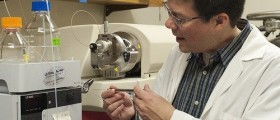
Acute myeloid leukemia is a malignant disease of the myeloid line of the blood cells. This type of cancer is distinguished by the rapid and abnormal growth of white blood cells that accumulate in the bone marrow and obstruct the normal production of blood cells.
Acute myeloid leukemia is distinguished from other associated blood disorders by the incidence of more than 20% blasts in the bone marrow. Acute myeloid leukemia is also known as acute myelogenous leukemia, acute myeloblastic leukemia, acute granulocytic leukemia and acute non-lymphocytic leukemia.
Symptoms
Acute myeloid leukemia occurs as a result of damaged DNA in developing cells in the bone marrow. Immature blood cells, produced by the bone marrow, thus develop into leukemic blood cells known as myeloblasts. Leukemic cells are unable to function and they gradually build up and suppress healthy cells.
A deficit of normal white blood cells makes the patient vulnerable to infections and diseases. Leukemic cells themselves have no infection-fighting capacity and thus the early signs of the disease may resemble to those of influenza or common cold. Signs and symptoms vary based on the type of blood cells affected. The majority of sufferers seek medical attention due to a sickness that may include fatigue, fever and recurrent infections, weight loss, night sweats, or bleeding. In many cases, patients are sick for a couple of weeks prior to seeking medical attention.
Causes of acute myeloid leukemia
Certain risk factors are associated with the development of acute myeloid leukemia. There are few hereditary causes of this disease. First-degree relatives of patients with acute myeloid leukemia are at the highest risk.
Exposure to various cancer-causing agents is also partially responsible for development of acute myeloid leukemia. Harmful substances from benzene, tobacco smoke or ionizing radiation are thus important risk factors.
However, most commonly acute myeloid leukemia develops in patients who have received chemotherapy treatment in order to manage other cancer diseases. Similarly, acute myeloid leukemia sometimes develops from pre-leukemic blood disorders such as myelodysplastic syndrome or myeloproliferative disease.
Diagnosis
Acute myeloid leukemia is diagnosed based on a complete clinical history and laboratory investigations. The complete blood count with abnormal values is the most precise indicator of this disease. The results of complete blood count test usually show elevated levels of white blood cells and low levels f red blood cells. Doctors will make an accurate diagnosis after the examination of a bone marrow sample.
Treatment
Acute myeloid leukemia is most commonly treated with chemotherapy, radiotherapy and biological therapy. Treatment is focused on lessening the symptoms of the disease and reducing the production of abnormal blood cells.
















Your thoughts on this
Loading...